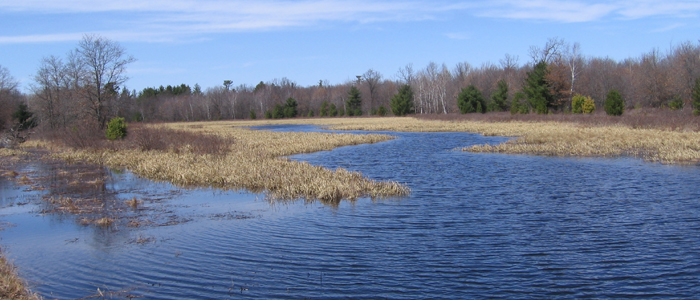Meadow Valley Wildlife Area
Meadow Valley Wildlife Area encompasses approximately 56,000 acres and is located in between Babcock and Necedah, about two hours north of Madison. It is 25 miles southwest of Wisconsin Rapids and 20 miles north of Mauston. Access can also be found 1 mile west of Babcock on Highway X.
Most of the land that makes up Meadow Valley Wildlife Area is federally owned land that is managed by the Department under a Cooperative Agreement with the US Fish and Wildlife Service. DNR staff manage the Sandhill Wildlife Area, Wood County Wildlife Area and the Meadow Valley Wildlife Area collectively. Together, these three Wildlife Areas are referred to as the Sandhill-Meadow Valley Work Unit. They make up the largest block of state-managed wildlife lands in Wisconsin. Nearly 150 square miles of public lands lie within the work unit.
Meadow Valley Wildlife Area provides a unique experience as it offers an exceptional variety of hunting and recreational opportunities. The diverse habitat management practices implemented on the property provide ample opportunities for hunting deer, wild turkey, ruffed grouse, small game, waterfowl, and trapping furbearers. In addition to hunting opportunities, the size and diversity of the property provide opportunities for hiking, berry picking and observing wildlife in a truly natural setting. The 1,175-acre wildlife refuge on Meadow Valley Flowage provides an excellent opportunity to observe migrating waterfowl in spring and fall.
Management Objectives
History
The wildlife area lies within the bed of old Glacial Lake Wisconsin. The topography is flat with a mixture of large marshes and low sandy ridges. Most of the sand was deposited by wind after the glacial waters receded.
During the late 1800s, settlers logged the large white and red pine that dominated the upland forest. The land clearing was completed, and numerous ditches were dug to farm the area after the turn of the century. A short and unpredictable growing season, poor soil and excessive drainage taxes caused most of the farms to be abandoned. The federal government purchased the tax-delinquent land under the Jones-Bankhead Farm Tenant Act. In 1940, the 90-square-mile Meadow Valley Wildlife Area was leased to the state of Wisconsin and is administered under a cooperative agreement with the U.S. Fish and Wildlife Service.
During the Civilian Conservation Corps era, numerous ditch plugs were installed and several areas were forested. Natural forest growth has reclaimed most of the remaining uplands and many of the camping areas are remnant farm fields. Most of the flowage areas on the property were constructed during the 1950s and '60s.
Management objective
Meadow Valley Wildlife Area is currently managed to provide a diverse landscape with a good interspersion of habitat types and stages of succession. Another important management objective is to provide examples of pre-settlement communities such as old-growth forests, oak barrens, sand prairies and sedge meadows.
Forest wildlife and waterfowl are the primary species managed on the property. The oak, pine, aspen and mixed forests provide optimum conditions for ruffed grouse, woodcock, deer, squirrels, wild turkey and furbearers. The managed flowages provide quality habitat for waterfowl, furbearers and a variety of threatened and endangered species.
Forested areas are carefully managed to provide the mixture of young, middle and old-age timber that is most conducive to wildlife production. This forest management scheme will also maintain a sustained yield of forest products.
Prescribed burning is used to encourage wetland vegetation by eliminating woody growth and releasing nutrients. Burning is occasionally used as a forest management tool to stimulate regrowth, reduce slash and prepare sites for planting. Drawdowns on flowages are used to improve feeding conditions for ducks and geese. This duplicates a natural cycle of wet and dry periods and improves habitat for all wetland species.
Future efforts will be directed toward improving the forest management program and maintaining the existing flowages. Public hunting and other compatible recreation will be the primary uses.
Visit the property planning for more information on master planning for this and other wildlife areas around the state.
Recreation
The Meadow Valley Wildlife Area (MVWA) offers many recreational opportunities:
- Birding
- Boating (non-motorized)
- Camping (see below for details)
- Canoeing
- Cross-country skiing (no designated trail)
- Fishing
- Hiking (no designated trail)
- Hunting (noted for waterfowl and turkey)
- Snowmobiling (restricted to marked trails)
- Trapping
- Wild edibles/gathering
- Wildlife viewing
Meadow Valley Wildlife Area is attractive to hunters and trappers because of its remote landscape. In addition to excellent hunting, the size and diversity of the property provide opportunities for hiking, berry picking, bird watching and observing wildlife in a natural setting. Other public uses include photography, fishing, snowshoeing and snowmobiling (restricted to marked trails). Canoeing and boating are allowed; however, no motors are permitted on any waters within the property.
All vehicular travel on interior access roads and dikes is prohibited. ATVs are not allowed on the MVWA. However, ATV use is permitted on some township roads within the MVWA. While at the camping areas, ATVs must remain on the trailer.
Meadow Valley Wildlife Area borders the Necedah National Wildlife Refuge, on the Refuge’s west side. Although these two areas are connected and owned by the USFWS, they are managed separately. Please check each property's website for details regarding hunting and recreation.
Amenities
- Bathroom - There are four pit toilets scattered throughout the property, associated with campgrounds. See the property map for locations.
- Parking lot - Parking lots are associated with campgrounds, as well as scattered lots throughout the property. See the Maps tab for more details.
- Campground and size - There are 9 dispersed/primitive camping areas throughout the property (see map for locations)
- Only open Sept. 1 through Dec. 31 and during the spring turkey seasons
- Primitive camping is permitted at designated sites, free of charge during the open seasons. Campers are required to self-register. Some of the campsites offer pit toilets. Campers must bring their own water. All garbage must be removed from campgrounds.
- Trails, Types and Lengths - There are no designated recreational trails on the property. There are several managed roads, dikes, and hunter access trails suitable for hiking/recreation.
Maps
Meadow Valley Wildlife Area map [PDF]
Eagle Nest Flowage [PDF]
Meadow Valley and Beaver Flowages [PDF]
Dandy Creek Flowage [PDF]
Jackson Unit [PDF]
If you are interested in exploring this property further, you can access an interactive map.


